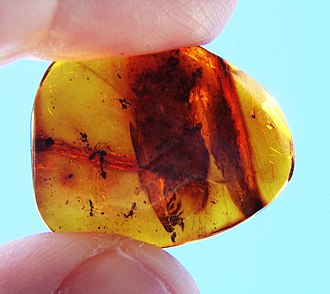Ant
File:Blackants-bredcrust-tokyo-may2015.webm




Ants are a group of eusocial insects that belong to the family Formicidae within the order Hymenoptera, which also includes bees and wasps. Ants evolved from wasp-like ancestors in the Cretaceous period, around 140 million years ago, and have since diversified into a wide variety of species that are found on all continents except Antarctica. They are particularly prevalent in tropical forests, where they may constitute up to 25% of the terrestrial animal biomass.
Characteristics[edit]
Ants are easily identifiable by their elbowed antennae and a distinctive node-like structure that forms their slender waists. Adult ants typically fall into one of three roles within their highly organized social structure: queens, workers, or males. Queens are the reproductive females that establish new colonies and lay eggs; workers are non-reproductive females that gather food, care for the queen's offspring, and protect the community; males are winged ants whose primary role is to mate with the queen.
Behavior and Ecology[edit]
Ants exhibit complex behaviors and have the ability to organize vast colonies; some are known to consist of millions of individuals. Their social structure is based on an efficient division of labor and a sophisticated communication system that relies heavily on chemical signals known as pheromones. Ants are capable of finding food sources and communicating their location to other members of the colony, engaging in warfare with other colonies, and forming mutualistic relationships with other species, such as aphids and certain types of fungi.
Foraging and Food[edit]
Ants are omnivorous and have a diverse diet that includes nectar, fungi, seeds, and insects. Some species have specialized feeding habits, such as the leafcutter ants that cultivate fungus, which they feed on, by cutting and transporting leaves to their colonies.
Communication[edit]
Communication among ants is sophisticated and primarily chemical. Pheromones are used for a variety of purposes, including marking food trails, signaling alarm, and controlling reproduction. Physical communication, such as antennal contact and body language, also plays an important role in the social life of ants.
Reproduction and Life Cycle[edit]
The life cycle of ants begins with the mating flight, during which virgin queens mate with males and then land to start a new colony. After mating, males typically die, while fertilized queens shed their wings and seek a suitable nesting site. The queen lays her initial batch of eggs, which hatch into larvae that are entirely dependent on her for food. As these larvae develop into adult workers, they take over the duties of foraging, nest maintenance, and care of subsequent offspring produced by the queen.
Ant Societies[edit]
Ant societies are characterized by a high degree of cooperation and complex social organization. The colony, or nest, is the central unit of ant life, and activities are coordinated to support the survival and reproduction of the colony rather than individual ants. This eusocial behavior includes division of labor, cooperative care of the young, and, in some species, the presence of sterile castes.
Impact on the Environment and Humans[edit]
Ants play a vital role in the environment as predators of pests, dispersers of seeds, and aerators of the soil. However, some species are considered pests themselves, particularly when they invade homes in search of food or shelter. Notably, the red imported fire ant (Solenopsis invicta) and the Argentine ant (Linepithema humile) have been known to cause economic damage and ecological disruption in areas where they have been introduced.
Conservation[edit]
While ants are abundant and widespread, certain species are threatened by habitat loss and the use of pesticides. Conservation efforts are important to maintain biodiversity and the ecological roles ants play.
Ad. Transform your life with W8MD's Budget GLP-1 injections from $75


W8MD offers a medical weight loss program to lose weight in Philadelphia. Our physician-supervised medical weight loss provides:
- Weight loss injections in NYC (generic and brand names):
- Zepbound / Mounjaro, Wegovy / Ozempic, Saxenda
- Most insurances accepted or discounted self-pay rates. We will obtain insurance prior authorizations if needed.
- Generic GLP1 weight loss injections from $75 for the starting dose.
- Also offer prescription weight loss medications including Phentermine, Qsymia, Diethylpropion, Contrave etc.
NYC weight loss doctor appointmentsNYC weight loss doctor appointments
Start your NYC weight loss journey today at our NYC medical weight loss and Philadelphia medical weight loss clinics.
- Call 718-946-5500 to lose weight in NYC or for medical weight loss in Philadelphia 215-676-2334.
- Tags:NYC medical weight loss, Philadelphia lose weight Zepbound NYC, Budget GLP1 weight loss injections, Wegovy Philadelphia, Wegovy NYC, Philadelphia medical weight loss, Brookly weight loss and Wegovy NYC
|
WikiMD's Wellness Encyclopedia |
| Let Food Be Thy Medicine Medicine Thy Food - Hippocrates |
Medical Disclaimer: WikiMD is not a substitute for professional medical advice. The information on WikiMD is provided as an information resource only, may be incorrect, outdated or misleading, and is not to be used or relied on for any diagnostic or treatment purposes. Please consult your health care provider before making any healthcare decisions or for guidance about a specific medical condition. WikiMD expressly disclaims responsibility, and shall have no liability, for any damages, loss, injury, or liability whatsoever suffered as a result of your reliance on the information contained in this site. By visiting this site you agree to the foregoing terms and conditions, which may from time to time be changed or supplemented by WikiMD. If you do not agree to the foregoing terms and conditions, you should not enter or use this site. See full disclaimer.
Credits:Most images are courtesy of Wikimedia commons, and templates, categories Wikipedia, licensed under CC BY SA or similar.
Translate this page: - East Asian
中文,
日本,
한국어,
South Asian
हिन्दी,
தமிழ்,
తెలుగు,
Urdu,
ಕನ್ನಡ,
Southeast Asian
Indonesian,
Vietnamese,
Thai,
မြန်မာဘာသာ,
বাংলা
European
español,
Deutsch,
français,
Greek,
português do Brasil,
polski,
română,
русский,
Nederlands,
norsk,
svenska,
suomi,
Italian
Middle Eastern & African
عربى,
Turkish,
Persian,
Hebrew,
Afrikaans,
isiZulu,
Kiswahili,
Other
Bulgarian,
Hungarian,
Czech,
Swedish,
മലയാളം,
मराठी,
ਪੰਜਾਬੀ,
ગુજરાતી,
Portuguese,
Ukrainian
